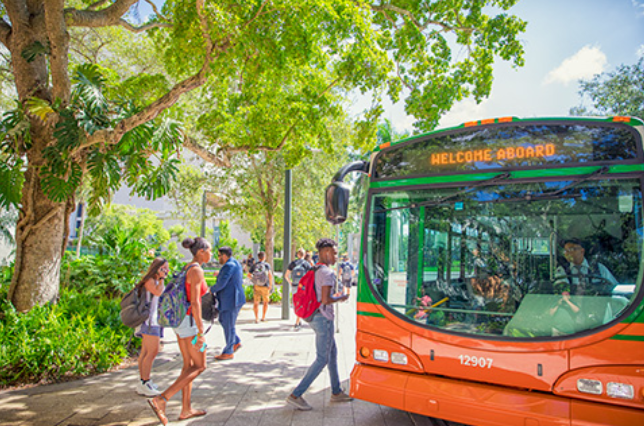As colleges and universities strive to create sustainable, safe and attractive campus environments, promoting alternative modes of transportation has become fundamental. From a financial and land use planning perspective it is essential for most universities to reduce single-occupancy vehicle trips. Not only do these alternative transportation modes help reduce carbon footprints, are financially smart, and allow for the highest and best use of campus space, but they also contribute to healthier lifestyles and decreased traffic congestion. Here are five effective strategies, in no specific order, to encourage students and faculty to adopt alternative transportation methods and help reduce campus parking demands:
1. Awareness Campaigns: Launch comprehensive awareness campaigns that highlight the benefits of biking, walking, public transit, and carpooling. Use posters, social media, and campus events to spread the message. Provide educational materials on the University website and in public spaces regarding public transportation and carpooling policies. Organize fun and engaging events such as bike-to-school days or walk-a-thons. These events can foster community spirit while encouraging students to try out alternative transportation. Consider implementing challenges with prizes to motivate participation and create excitement around using alternatives to cars. A bicycle or electric scooter is a great prize. These campaigns should emphasize health benefits, cost savings, and environmental impact to resonate with students.
2. Financial Incentive: Provide financial incentives to students and employees who choose alternative transportation methods. Increasing the parking rate and charging per use of parking (e.g. monthly, daily, hourly rates) makes it less attractive to drive and park on campus. There is an elasticity of demand regarding parking rates, where the parking demand decreases with an increase in parking rates, which is dependent on the availability and convenience of alternative transportation modes. Subsidizing transit passes, carpooling/vanpooling services, bike/scooter share services, and even on-demand carshare services (e.g. Uber and Lyft) make these options more attractive and a smart financial decision. An employee parking cash-out program is effective, where you pay employees to not drive and park on campus. Depending on the campus, the financial incentives to promote alternative transportation modes could be less costly than constructing and maintaining additional campus parking. This cost-benefit analysis is dependent on land costs, amount of available space, and need for additional parking. Separate from the cost-benefit analysis, the highest and best use of campus space is not parking, but instead academic buildings, residences, green space, or campus amenities.
3. Infrastructure Improvements: It is essential to invest in the necessary infrastructure to support alternative transportation. This could include adding more bike racks, constructing bike lanes, creating safe walking paths, adding transit routes/stops, improving lighting, providing premium spaces for carpool/vanpool vehicles, or enhancing access to nearby public transit options. In addition to improving transportation infrastructure, it is also very impactful to construct student and employee housing on-campus. Something that doesn’t necessarily reduce parking demand, but will help reduce vehicle trips is providing on-campus amenities such as a cafeteria, restaurants, recreation and relaxation areas. As most university funds and resources are limited, infrastructure improvements should be prioritized based on cost, complexity, and projected impact.
4. Policy Changes: University policies can have a huge impact on reducing vehicle trips and parking demand. However, many of these policy changes require support from the administration and students to get effectively passed. One major policy is preventing certain students or employees from having a car on campus or acquiring a parking permit. This can be dependent on seniority, distance of residence from campus, and need based. Another policy discussed previously is parking pricing and structure (i.e. annual, monthly, daily, or hourly). The greater the price and more people have to consider paying for parking, the more they consider alternative options. Staggered class schedules and online classes are a great way to reduce parking demand. It is essential to make a great business case, especially reducing parking permits offered, to get these types of policies implemented.
5. Partnerships with Transit Authorities and Private Transportation Companies: Collaboration with local transit authorities to offer discounted student fares, additional campus routes/stops, and increased frequency is essential. By making public transit more accessible and affordable, colleges can encourage more students to opt for this sustainable mode of travel. Contracting with ride hailing, carshare and carpooling vendors can be a great option to provide vehicles for short term use, shared bikes/scooters, discounted Uber/Lyft, and carpooling matching services on campus. Car and bike/scooter share services are a great first/last mile solution and can help getting around campus. Carshare services (e.g. Zipcar) are helpful for students and employees that don’t own a vehicle but need a vehicle at times.
By employing these strategies, universities can foster a culture of sustainability, create a more desirable campus environment, and encourage their communities to embrace alternative modes of transportation. The benefits extend beyond the individual to the campus as a whole, contributing to a healthier environment, financially sustainable transportation system, and improved campus life.


